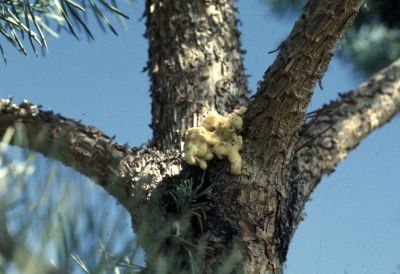Nobody likes to be taken advantage of, even (and maybe especially) trees. But that’s exactly what the Zimmerman pine moth does: take advantage of weakened and stressed trees. From larvae to adult, the insect looks for existing wounds or vulnerable areas – a broken branch, bark that has fallen away, even the tips of young branches – and tunnels in to feed and nest or lays eggs that will feed on sap after hatching.
It’s especially fond of Austrian pines, but the Zimmerman pine moth is also found on Scotch and ponderosa pines. They are brazen pests and it is important to take steps in Zimmerman pine moth treatment. It’s usually very easy to spot the undeniable signs of an infestation. Bubbly pitch is produced from the moth’s activity throughout all life stages. It looks like a small handful of popped popcorn and is most often seen in the crotch of a branch.
Of course, healthy trees are at less risk for any infestation or disease. Basic preventive care is often the best defense against opportunistic pests.
Because the Zimmerman pine moth’s life cycle results in at least eight months of active damage, chemical Zimmerman pine moth treatment may be required to save a tree. The best time for chemical treatment is when caterpillar larvae are active on the outside of the tree in spring. Zimmerman pine moth treatment immediately after hatching in August can also control pests, but timing must be precise because the hatchlings tunnel into bark very quickly.
Contact SprayTech, Colorado commercial and residential weed and tree spraying specialists, at 720-248-0000 if you suspect a Zimmerman pine moth infestation on your property.
Comments are closed.